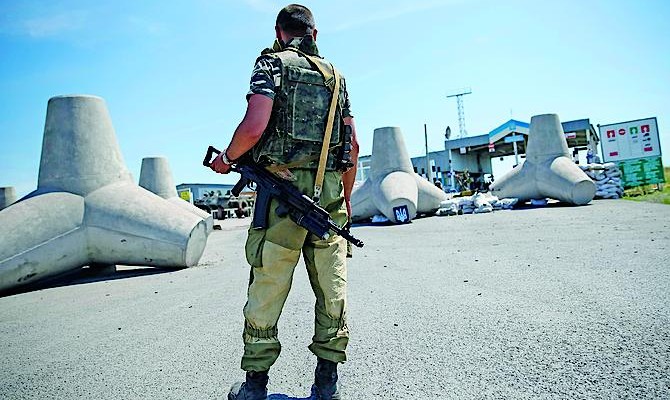Politics
hot spotsUkraine considers the possibility of completely closing its border with Russia

Today the National Security and Defense Council (NSDC) will hold a meeting at which it is expected to approve the plan for further steps in the anti-terrorist operation (ATO) in the eastern part of the country. In particular, it will discuss the restoration of the state border Ukraine lost control over in recent months. At the same time, the introduction of martial law in the Donbas is unlikely due to the president’s desire to hold early elections to the Verkhovna Rada.
Ambitious goals
The reason for the NSDC meeting was the tragedy in the Luhansk oblast. As a reminder, this Saturday pro-Russian militants of the self-proclaimed People’s Republic of Luhansk shot down a military transport plane Il-76 of the Armed Forces of Ukraine, killing 49 soldiers and 9 members of the crew on board.
Capital’s source in the Presidential Administration said a decision was made to take two days for the preparation of the NSDC meeting hoping that the law enforcement ministries would draft their vision of settling the conflict in the eastern part of the country and reducing losses of military personnel, employees of the State Security Service and the Interior Ministry involved in the ATO.
Spokesperson of the NSDC Secretary Yarema Dukh said the time, place and agenda for the meeting of the council are classified. But earlier President Poroshenko announced the main issues on the agenda of the NSDC. “On the agenda are measures aimed at restoration of the state border and decisive steps for implementation of a peace plan in the Donbas,” said Poroshenko. The president said this weekend during the ATO the Ukrainian army initiated an offensive for the first time.
Capital’s source in the Defense Ministry said that over the weekend the army was able to establish control over almost 250 km of the national border, which was previously not controlled by Ukraine’s law enforcers. Adviser to the Interior Minister Serhiy Herashchenko, who previously announced full control over the border, in an interview with Capital this Sunday admitted that law enforcers failed to fully execute such a plan of action. “We control most of the border. There are more uncontrolled areas in the Luhansk oblast, fewer in the Donetsk oblast. Our current task is to make it impossible for major militant groups to cross the border. Unfortunately, they will certainly be able to cross the border individually, but we should at least block the access of tanks”, said Herashchenko.
Deputy Interior Minister Mykola Velychkovych told the newspaper that the Interior Ministry is completing drafting of a package of proposals aimed at reinforcement of the State Border Service, which will be submitted to the NSDC. Nonetheless, Velychkovych refused to disclose any details.
Former Defense Minister and MP representing the Economic Development Group Oleksandr Kuzmuk expects that today the NSDC will make a decision on closing the border with Russia, as it involves the restoration of control over all the checkpoints. After this border guards will be joined by the army and, perhaps, the National Guard of Ukraine, as well as volunteer battalions. “We should control all destinations currently known to the raiding forces where smugglers have been crossing the border. Of course, mobile groups of the AFU and aviation should patrol the border. Besides, at the moment there is no heavy flow of goods from Ukraine to Russia and back, so it is possible to discard to this issue”, said Kuzmuk.
At the same time, Capital’s source in the Presidential Administration said it has not yet been decided whether the border should be closed only in the Donbas region, or also in other oblasts in the northeast of the country. “There is also an issue regarding the border with Belarus, which, if truth be told, we control quite poorly. Still, it should be noted that Belarus has no border with Russia,” he stressed.
Corridor passage
The second important step for the NSDC should be the decision to create an “escape corridor for the withdrawal of civilians from the zone of conflict”, says Kuzmuk. At the same time, the ATO headquarters claims that such a corridor is already functioning. ATO press officer Oleksiy Lebid says it is possible to drive or walk through the checkpoints after a thorough inspection. If there is no suspicion that certain individuals belong to a terrorist group, they and their vehicles are escorted from the conflict zone under the supervision of law enforcers. He added that during such inspection special attention is being paid to individuals exiting the hotspots.
Nevertheless, Director of the Center for Army, Conversion and Disarmament Studies Valentyn Badrak says the idea of a humanitarian corridor could be efficiently implemented only on condition of the creation of filtration camps. “Some people believe that the simplified approach would ease the tension, but I do not support such point of view: everything moving from the zone of conflict towards other regions should be very stringently checked,” assured the expert.\
However, as a reminder, earlier VR Commissioner for Human Rights Valeriya Lutkovska denied information about the plans of the Kyiv authorities to create filtration camps. Furthermore, Capital’s source in the Presidential Administration predicted that the issue of martial law is unlikely to be discussed at the NSDC meeting. “The president has the right to declare martial law independently. In such a case he would only need the approval of the government. But in that case the dissolving of the parliament and appointment of early elections promised by Poroshenko would be prohibited by the law,” the source summed up.





 of the agreement of syndication with Financial Times Limited are strictly prohibited. Use of materials which refers to France-Presse, Reuters, Interfax-Ukraine, Ukrainian News, UNIAN agencies is strictly prohibited. Materials marked
of the agreement of syndication with Financial Times Limited are strictly prohibited. Use of materials which refers to France-Presse, Reuters, Interfax-Ukraine, Ukrainian News, UNIAN agencies is strictly prohibited. Materials marked  are published as advertisements.
are published as advertisements.